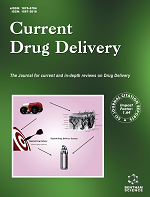- Home
- A-Z Publications
- Current Drug Delivery
- Previous Issues
- Volume 22, Issue 4, 2025
Current Drug Delivery - Volume 22, Issue 4, 2025
Volume 22, Issue 4, 2025
- Thematic Issue: Materials Chemistry and Engineering for Drug Delivery
-
-
-
Advances in Enzyme-responsive Supramolecular In situ Self-assembled Peptide for Drug Delivery
More LessAuthors: Wentao Xu, Xiaowen Qin, Yang Liu, Jun Chen and Yuguang WangBecause of low immunogenicity, ease of modification, and inherent biosafety, peptides have been well recognized as vehicles to deliver therapeutic agents to targeted regions with improved pharmacokinetic characteristics. Enzyme-responsive self-assembled peptides (ERSAPs) show superiority over their naive forms due to their enhanced targeting efficacy and long-retention property. In this review, we have summarized recent Read More
-
-
-
Biological Properties of Arginine-rich Peptides and their Application in Cargo Delivery to Cancer
More LessAuthors: Minghai Ma, Ruizhao Zhao, Xing Li, Minxuan Jing, Rundong Song and Jinhai FanCell-penetrating peptides (CPPs) comprise short peptides of fewer than 30 amino acids, which are rich in arginine (Arg) or lysine (Lys). CPPs have attracted interest in the delivery of various cargos, such as drugs, nucleic acids, and other macromolecules over the last 30 years. Among all types of CPPs, arginine-rich CPPs exhibit higher transmembrane efficiency due to bidentate bonding between their guanidinium groups and ne Read More
-
-
-
The Blood-prostate Barrier: An Obstacle to Drug Delivery into the Prostate
More LessAuthors: Yixuan Mou, Min Cao and Dahong ZhangThe blood-prostate barrier (BPB), a non-static physical barrier, stands as an obstacle between the prostate stroma and the lumen of the prostate gland tube. The barrier has the ability to dynamically regulate and strictly control the mass exchange between the blood and the prostate, thereby limiting drug penetration into the prostate. The basement membrane, fibrous stromal layer, capillary endothelial cell, prostatic ductal ep Read More
-
-
-
Targeted Polymeric Nanoparticles as a Strategy for the Treatment of Glioblastoma: A Review
More LessGlioblastoma multiforme is the most common and aggressive malignant tumor that affects the central nervous system, with high mortality and low survival. Glioblastoma multiforme treatment includes resection tumor surgery, followed by radiotherapy and chemotherapy adjuvants. However, the drugs used in chemotherapy present some limitations, such as the difficulty of crossing the blood-brain barrier and resisting the cell Read More
-
-
-
Nanocarriers for siRNA Delivery Aimed at the Treatment of Melanoma: Systematic Review
More LessMelanoma is a malignant skin cancer type with a high lethality rate due to active metastasis. Among the risk factors for its development is exposure to ultraviolet radiation (UV) and phenotypical characteristics such as clear skin and eyes. Given the difficulties of the conventional therapy, the high cost of the treatment and the low bioavailability of drugs, it is important to develop new therapeutic methods to circumvent this situatio Read More
-
-
-
Conjugated Linoleic Acid in Cancer Therapy
More LessAuthors: Jeneesha George and Asit Ranjan GhoshConjugated Linoleic Acid (CLA) is a polyunsaturated dietary fatty acid. Probiotics can biohydrogenate CLA with multiple health benefits, especially in cancer treatment. In vitro, in vivo, and clinical studies have confirmed CLA isomers to possess anti-cancer activity. CLA has demonstrated its potential as an alternative treatment for cancer and also used as an adjuvant to reduce the side effects of existing treatment methods. Read More
-
-
-
TPGS-modified Chitosan Nanoparticles of EGFR Inhibitor: Physicochemical and In vitro Evaluation against HepG2 Cell Lines
More LessAuthors: Mahendra Singh, Alka, Prashant Shukla, Zhi-Hong Wen, Chou-Yuan Ko and Ramachandran VinayagamBackgroundGefitinib (GFN) is an Epithelial Growth Factor Receptor (EGFR) inhibitor, and Food and Drug Administration (FDA) has approved medication to treat lung cancer. However, this investigation aimed to produce and characterize Gefitinib (GFN)-loaded chitosan and soy lecithin nanoparticles (NPs) modified with D-α-tocopheryl polyethylene glycol 1000 succinate mono ester (TPGS) and assess their therapeutic po Read More
-
-
-
TPGS-mediated Transethosomes Enhance Transdermal Administration of Curcumin via Effects on Deformability and Stability
More LessAuthors: Teng Guo, Chenming Zhang, Yuling Chen, Yihan Wu, Zhenda Liu, Yongtai Zhang and Nianping FengBackgroundAdding a suitable surfactant can enhance the transdermal permeability of transethosomes while also leveraging its functionality as a functional material. In this study, transethosomes were prepared using D-α-tocopherol acid polyethylene glycol succinate (TPGS) as edge activators for transdermal delivery of curcumin (Cur).MethodsThe TPGS-mediated curcumin-loaded transethosomes (Cur@TES) were prepared an Read More
-
Volumes & issues
-
Volume 22 (2025)
-
Volume 21 (2024)
-
Volume 20 (2023)
-
Volume 19 (2022)
-
Volume 18 (2021)
-
Volume 17 (2020)
-
Volume 16 (2019)
-
Volume 15 (2018)
-
Volume 14 (2017)
-
Volume 13 (2016)
-
Volume 12 (2015)
-
Volume 11 (2014)
-
Volume 10 (2013)
-
Volume 9 (2012)
-
Volume 8 (2011)
-
Volume 7 (2010)
-
Volume 6 (2009)
-
Volume 5 (2008)
-
Volume 4 (2007)
-
Volume 3 (2006)
-
Volume 2 (2005)
-
Volume 1 (2004)
Most Read This Month
Article
content/journals/cdd
Journal
10
5
false
en

Most Cited Most Cited RSS feed
-
-
Preface
Authors: Deng-Guang Yu and He Lv
-
- More Less

